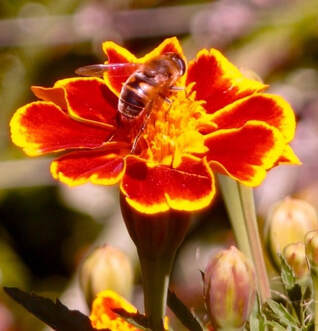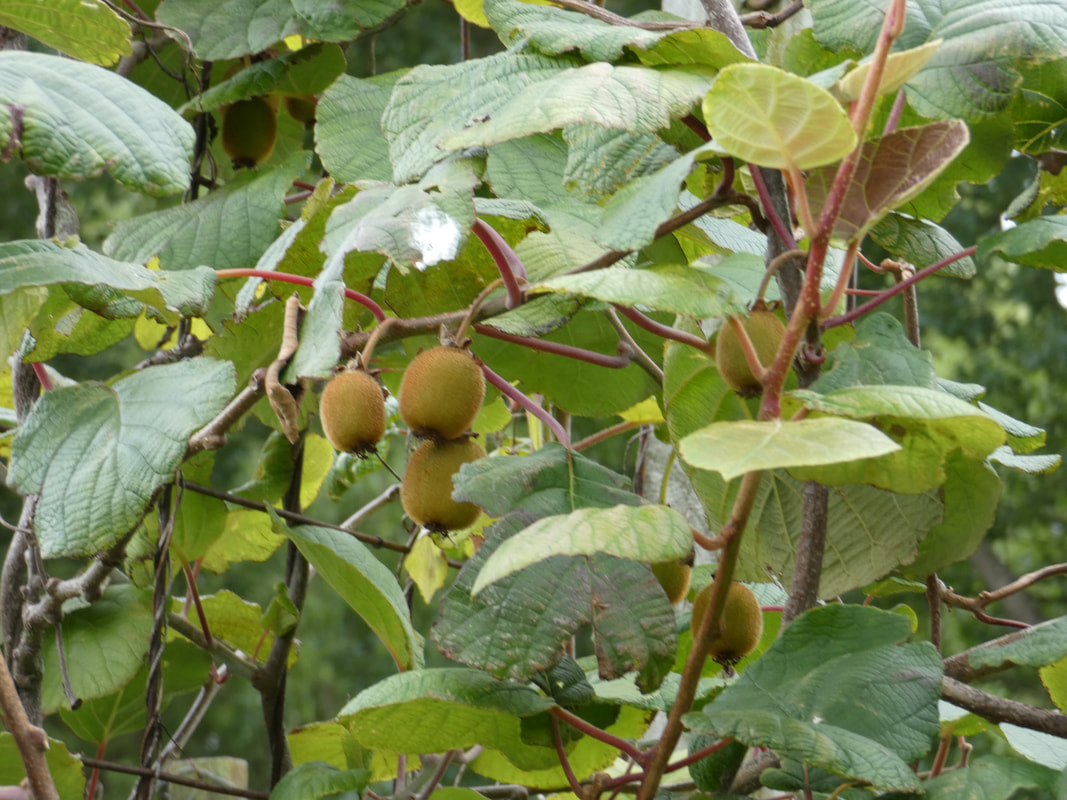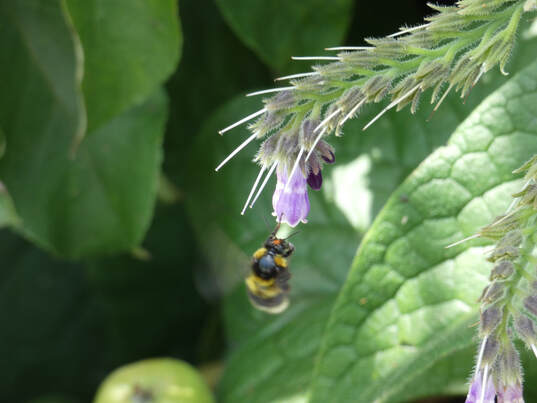 Drone fly on a marigold
Drone fly on a marigold In November 2016 I started a blog post by saying "My garden is humming with bees of all kinds.." This year it's January, and I can't find any honeybees in my garden whatsoever. I think the number I may have seen over the last couple of months could be counted on one hand. I was thinking that it's been a slow-to-warm-up season, but the temps are now high, and still no bees. And yes, it can very from season to season and place to place. However, given what is flowering in my garden right now, I would expect to be seeing at least some honeybees. This includes: marshmellow (normally swarming with them), sage (likewise), nasturtium, buttercup, big patches of white clover, some red clover, feijoa, zucchini, zinnia, purple deadnettle (they usually love that), pansies, roses, agapanthus, dahlia, brassicas (also normally a huge draw), strawberries, chives, celery, dandelion, convolvulus, star jasmine, potato vine, raspberries, comfrey and more.
Bees do have a very powerful sense of smell - about 100x stronger than ours - and there is major work being done a couple of kms from me, which includes river dredging, earth moving, and the laying of massive amounts of very fresh, very stinky compost. The smell is close to unbearable in many parts of town, including here. Maybe that's scared them off. This work has been going on for a while, but the smell has only been bad since they started with the compost a week or so ago. So it doesn't explain the bee free summer. I have a commercial bee keeper based in the street behind us (on a small block); I should ask him whether he has any hives at home currently, and how his bees are doing!
Anyway, whatever the reason for the current dirth, the main point of this post is to discuss all the pollination that is STILL happening, even without the honeybees, and how. As gardeners, we WANT lots of pollination - without it we would severely lack in a lot of crops, and also wouldn't get viable seed to save. Bees are in trouble all over the world; they are very important, but I think folk are often not aware of how many other pollinators there are out there. When we think about encouraging beneficial critters to our gardens, we should not plant only for bees, but also consider the more humble critters and their needs. Even some pests have their upsides in terms of the pollinating services they provide.
Bees do have a very powerful sense of smell - about 100x stronger than ours - and there is major work being done a couple of kms from me, which includes river dredging, earth moving, and the laying of massive amounts of very fresh, very stinky compost. The smell is close to unbearable in many parts of town, including here. Maybe that's scared them off. This work has been going on for a while, but the smell has only been bad since they started with the compost a week or so ago. So it doesn't explain the bee free summer. I have a commercial bee keeper based in the street behind us (on a small block); I should ask him whether he has any hives at home currently, and how his bees are doing!
Anyway, whatever the reason for the current dirth, the main point of this post is to discuss all the pollination that is STILL happening, even without the honeybees, and how. As gardeners, we WANT lots of pollination - without it we would severely lack in a lot of crops, and also wouldn't get viable seed to save. Bees are in trouble all over the world; they are very important, but I think folk are often not aware of how many other pollinators there are out there. When we think about encouraging beneficial critters to our gardens, we should not plant only for bees, but also consider the more humble critters and their needs. Even some pests have their upsides in terms of the pollinating services they provide.
| How do I know that pollinating has been carried out in my garden? The evidence is all around me.... kiwifruit growing steadily, along with Chilean guava, raspberries, zucchini, cucumber, apples, pears and plums. Without insect pollination, I might have a handful of raspberries, but the rest of this lot would be fruitless. (Other fruit like feijoas and grapes are not insect pollinated - birds and wind respectively take care of those). The maturing brassica seeds which are now sprouting new plants are also evidence of pollination over the last few months, along with other seed on other insect pollinated plants. |
Some pollinating species
So what is doing the pollinating? Honestly, ALL the insect numbers seem to be down so far this season (possibly due to the cold - we had the fire going on three days between Christmas and New Year!), but over the last few days I've been paying close attention to what is out there, and I've observed:
- Bumblebees - there is a nest of them in the space between the walls of my greenhouse and a shed, and they are actively working in the garden. Bumblebees are fascinating critters - read more about them HERE.
- Drone flies - these are often mistaken for fat bees, but are in fact a type of hoverfly (named drone fly because of their resemblance to a bee drone), and are excellent pollinators. They breed by laying eggs in water with high organic content - I must put out a bucket of manure and water to encourage them. The larvae are called rat-tailed maggots and often freak people out, but they are harmless. When ready to pupate they crawl out of the water and drop to the ground.
- Native bees and wasps - there are a number of species of native bees and wasps, some of them very tiny and easily overlooked. The bees in particular are important pollinators. I've noticed a few in flowers around the garden.
- Flies, gnats and mozzies - the bugs everyone loves to hate. But in the garden many of them do an amazing job of pollinating - flies are considered second only to bees for pollinating, and in some places there would be major crop failures without them, especially when bees are scarce.
- Butterflies - there aren't many monarchs around this year either yet, and white butterflies are only just starting to pick up in number. Both are excellent pollinators, along with most other butterflies.
- Moths - most moths feed on flowers and thus are also excellent pollinators, including those moths whose larvae are pests, such as brown moths (green looper caterpillars), Diamondback moths (larvae eat brassicas), etc
- Syrphid (hoverflies) - these wee critters hover in the air and then zip quickly from place to place. They are also great pollinators, especially of plants with small flowers. I've spotted them in my flowering celery.
- Other pollinators - number of other critters pollinate various plants too, ranging from weevils to birds. I may not have seen them all in action, but I know they're there.
Encouraging pollinators
Like all critters, all those pollinators need food, habitat and (often) water. Some ways to encourage them include:
- Plant lots of flowers - some favourites are phacelia, calendula, clovers, oregano, lavendar, rosemary, borage, yarrow, tansy, fennel, chives, nasturtiums, foxglove, echinacea, sage, lemon balm. Aim to have a number of things flowering at any given time, year round.
- Leave some plants to flower you ordinarily wouldn't - all the brassicas are great, celery, carrots, parsnips, leeks, spring onions etc all attract lots of bees and other pollinators.
- Avoid using sprays - nearly all sprays are harmful to more than just their targets.
- Think about how you manage pests - some of them are also doing you a service. Finding the right balance is key.
- Have "wild areas" in your garden - that might be a corner where there are tall grasses mixed with weeds and wildflowers which you allow to get messy; this may be key habitat for hiding both beneficial pollinators, and natural pest predators.
- Consider making a "bug hotel"- a structure with a variety of materials and spaces in it that various bugs can make their homes in.
- Have shallow, clean water available - a bird bath or bowl which bees and bugs can get water from without drowning is what you want. This can be achieved by putting bricks or rocks as landing platforms into a bowl of water too. Birds also appreciate water to bathe in and drink.
- Have some flat rocks or old bricks here and there. Blackbirds and thrushes loves to use them to smash snails against. Lizards may soak up the sun on them. Worms may enjoy the cool moisture underneath them. One always has to think beyond the immediate and consider the bigger scope of what a diverse ecosystem in your garden needs to sustain and balance itself.
- Be observant - wherever your go, whether in your own garden or elsewhere, notice what is growing, and what critters you might see. Consider whether this gives you ideas of what to add to or increase in your garden.
Final thoughts...
Back when I first started seriously gardening in 2013, I concentrated on growing crops to eat. Within the first year, though, I quickly began to realise how important a range of beneficial insects and other creatures in the garden is - for pollination, pest control, and the overall health of the garden. So I started planting more flowers, flowering herbs, etc in my second year. It was incredible how quickly a diverse population of critters moved into my garden! Over time, the predatory ones began to control many of my pests - taking care of the looper caterpillars, most of the brassica pests, even psyllid and other problems. Others continued to pollinate or support the garden in other ways. And yes, to have good populations of anything beneficial, you also need populations of the things they rely on. Ladybugs, for example, are good pollinators too. But they also need aphids to feed on, especially for their young. Same goes for lacewings. If I made it my mission to kill every aphid, well I wouldn't have many ladybugs or lacewings working in my garden.
With the more limited gardening I've been able to do over the last couple of years, there are a lot less flowers in my garden, though still a fair range. One of my intentions is to add more and see an increase in overall beneficial insect populations, including pollinators.
Sometimes it's important to think outside of our usual "box." Also, by doing the things mentioned above, we can play our part to help the honeybees as well as our native bees and bumblebees (many of these are endangered), as well as the wider pollinator population.
With the more limited gardening I've been able to do over the last couple of years, there are a lot less flowers in my garden, though still a fair range. One of my intentions is to add more and see an increase in overall beneficial insect populations, including pollinators.
Sometimes it's important to think outside of our usual "box." Also, by doing the things mentioned above, we can play our part to help the honeybees as well as our native bees and bumblebees (many of these are endangered), as well as the wider pollinator population.


 RSS Feed
RSS Feed
